Table of Contents
For small business owners who work with hourly employees, every minute they track on their timesheets counts.
That’s because it’s essential for employers to understand what staff members are working on and how much time employees need to carry out all their tasks. Many business owners also want assurance that their team members are spending and accounting for their time responsibly — it might seem like overkill, but squandered time quickly adds up and ends up costing you.
That’s where employee attendance trackers come in handy. Once small business owners have these realizations, they often start looking to transition away from pen-and-paper systems to punch clocks or biometric time clocks. But then they realize:
- They’re not the most reliable as they don’t prevent buddy punching and other forms of time theft.
- They won’t help you stay compliant as they can’t help you track overtime or breaks to stay ahead of state and local labor laws.
- They don’t make payroll easier as you still have to export your time tracking data and build timesheets on your own.
So, what’s the fix for this? Attendance tracking software, which isn’t as intimidating as it sounds. Time and attendance tracking software is a valuable — and often affordable — investment that can help you avoid a whole host of costly payroll errors and inaccuracies. That’s why we’ve developed this guide with everything you need to know about employee attendance trackers for your small business.
4 Ways to Track Employee Attendance
Time tracking can be as low-tech or as high-tech as you want it to be. But these are four common ways employers track employee attendance.
1. Pen and Paper Timesheets
The pen-and-paper method is inexpensive, flexible, and easy to implement and use, especially for small businesses. It may involve a printed spreadsheet or a piece of paper on a clipboard. You can use it to track employee hours, breaks, and even calculate overtime.
Pen and paper timesheets are a good fallback when you’re getting started, but they do have limitations. They require employees to work on an honor system, and some team members may be more precise about recording their working hours than others. And, if employers don’t carefully track and check employee hours, people can easily make mistakes or intentionally record the wrong start and end times.
2. Digital Timesheets
With digital timesheets, employees track their hours on an Excel spreadsheet or timesheet. They’re similar to paper timesheets but allow for more flexibility in terms of location — employees can record their hours anywhere as long as they have access to the timesheet link and the internet.
Like paper timesheets, digital timesheets are inexpensive and easy to use, but they can also make it easier for managers to process payroll, especially with the accounting functions on Excel or Google Sheets. Still, employers who use them also have to trust that their employees will be honest about tracking the hours they work. This disadvantage may not be sustainable or scalable enough for small businesses that are growing fast.
3. Punch Clocks
Many employers in industries like construction or manufacturing use punch clocks and time cards to track employee hours because they work well when you have limited access to computers or the internet on a work site.
Punch clocks have been around for decades, and you can find both analog and digital versions of them. To use a punch clock, employees typically insert their time cards into a slot and clock in or out. The punch clock then stamps their shift start and end times on the card.
Some employers prefer punch clocks because they allow for precise time tracking and can prevent some forms of time theft. However, you may not feel comfortable with punch clocks if you’re worried about “buddy punching,” which is when an employee clocks in or out for one or many absentee co-workers.
4. Biometric Time Clocks
Biometric time clocks may sound futuristic for the spreadsheet users among you, but they can be an effective way of preventing time theft. In particular, they’re a great way to prevent buddy punching, as they make clocking in for other people almost impossible.
How do they work? Biometric time clocks use unique identifiers like fingerprints, retina or iris scans, hand or face geometry scans, and even voice recognition to sign employees in and out of their shifts. And while they can help prevent time theft and its associated costs, they also come with some drawbacks.
First, some employees find biometric time clocks intrusive, and they’re not even legal in every state. Many states — like Illinois, Texas, Washington, and New York — have even implemented laws regulating their use.
If you want to implement a biometric time clock solution in your business, you’ll have to research your specific state’s laws. But in general, employers who want to use them will have to:
- Obtain employee consent before gathering any biometric data.
- Notify employees that they’re collecting their personal data and explain what they’re using it for.
- Declare they won’t sell, lease, trade, or profit from any workers’ biometric data.
- Follow all confidentiality, data storage, and information disposal regulations set by their state.
The Top 5 Attendance Tracking Software for Employees
Attendance tracking software can help you transition from tedious manual processes to a faster, easier, more error-free experience. Here are our top five recommendations.
1. Homebase Time and Attendance Tracking Software
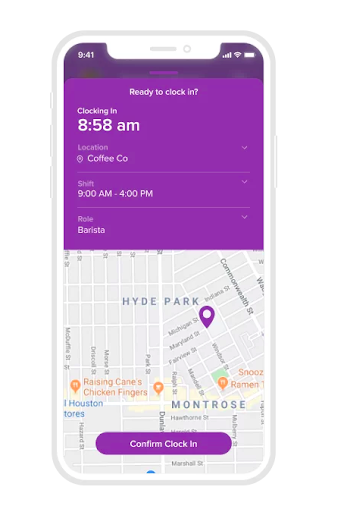
Source: https://joinhomebase.com/time-clock/
Caption: With Homebase, GPS location and clock-in photos make sure the right employees are signing into their shifts at the right times.
Homebase is a team management software solution built specifically for small businesses and hourly teams. It has features for time tracking, scheduling, hiring and onboarding, payroll, team communication, and HR and compliance.
Homebase has helped over 100,000 small business owners to transition from their pen-and-paper system to an intuitive app that’s a lot less intimidating than other solutions out there, and it only takes a few minutes to get started for free.
Main features
- Secure, mobile time clocks: Employees enter a unique PIN to clock in or out, so they don’t have to carry a punch card or submit a weekly timesheet. GPS locations and clock-in photos also prevent early clock-ins and buddy punching.
- Employee alerts before shifts: Homebase automatically notifies employees of their upcoming shifts, helping you avoid no-shows.
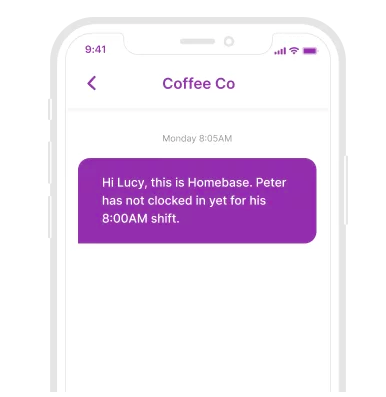
Source: https://joinhomebase.com/time-clock/
Caption: Homebase automatically notifies employees about their upcoming shifts and employers when their people are signing in late.
- Payroll integrations: Homebase’s time clock feature integrates with our payroll software and scheduling software, making it easy for managers to schedule employee shifts and process payroll directly out of employee timesheets. Employees can also stay up-to-date on their timesheets by checking their hours and pay in real-time.
- Secure information handling: Homebase stores your cloud-based time and attendance data for up to four years — two years beyond what the Fair Labor Standards Act (FLSA) laws require.
Pricing
You can sign up for Homebase time clocks and timesheets for free! Otherwise, you can access more features with the Essentials plan for $20/month, the Plus plan for $48/month, and the All in One plan for $80/month.
2. BambooHR
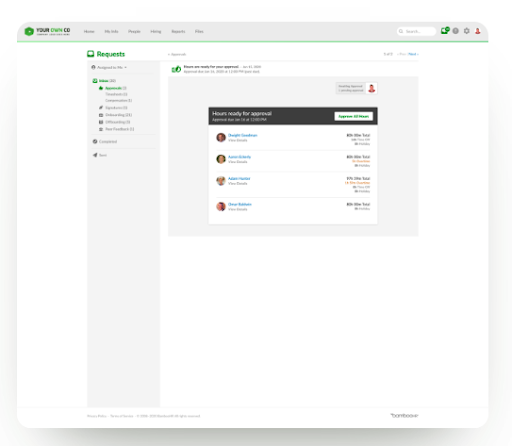
Source: https://www.bamboohr.com/time-tracking-software/
Caption: Managers can easily approve time off requests from within BambooHR’s platform.
BambooHR is a human resources information system (HRIS) that’s popular among both large and small business owners. Companies use it to automate and track HR operations like hiring and onboarding, compensation, company culture, and people data and analytics. And, as part of their compensation features, BambooHR provides users with tools for time tracking as well.
Main features
- Mobile app for time tracking: Employees can clock in and out from their phones with the BambooHR mobile app and take a look at their time off data.
- Payroll hours reports: BambooHR consolidates personal time off (PTO), regular hours, and overtime hours into payroll hours reports, which lets HR professionals and managers quickly check and approve employee hours before they run payroll.
- Security measures: BambooHR’s platform automatically logs you out of your session when you’re inactive for a certain period of time as a security feature. While some employees find this inconvenient, it’s meant to protect sensitive employee data.
Pricing
BambooHR’s Essentials plan starts at $5.25/month, and its Advantage plan starts at $8.75/month. Users then have the option to upgrade their plans with add-ons, including one for time tracking. Pricing for these additions isn’t readily available on their website.
3. Rippling
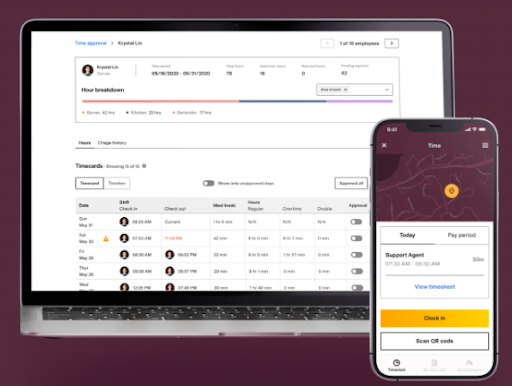
Source: https://www.rippling.com/time-and-attendance
Caption: Rippling lets you create automated workflows for managing time tracking.
Rippling is a software solution that companies use to track and manage their human resources, information technology, and finance operations in one unified platform. And among its HR products, Rippling includes tools for managing time and attendance.
Main features
- Create custom settings for tracking employee hours: Rippling lets you set up custom rules that the system triggers when certain conditions are met. So, for example, you can set a custom trigger for overtime pay when employees work a certain amount of hours.
- Pre-built workflow templates for time tracking: Rather than creating your own custom settings for employee hours, you can choose from one of Rippling’s templates.
- Integrates with Rippling’s other products for IT and finance: If you’re the owner of a larger business, you might appreciate the ability to consolidate your IT and financial data in one platform rather than relying on multiple different tools.
- Best for larger, more established businesses: Rippling’s functionality makes it a great solution for business owners with more people to manage. But it may not work for employers who are new to time tracking software, especially because some users report a lack of helpful customer support.
Pricing
Rippling starts at $8/month per user, and prices go up from there depending on the add-on features you want to include. Per add-on pricing isn’t available on Rippling’s website.
4. Bob
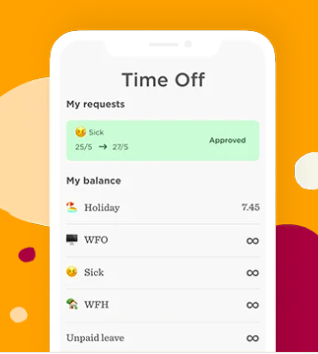
Source: https://www.hibob.com/
Caption: Bob’s mobile app lets employees easily check their time off requests and time off balances.
Bob is an HR platform built for on-site, remote, or hybrid workplaces and it has features for performance and culture management, as well as core HR operations like compensation and time tracking. With their time and attendance software, employees and managers can monitor hours worked, access time sheets, and get access to attendance records and data.
Main features
- Bob’s “quick fix” feature: If an employee wants to adjust their hours or if they forget to clock in or out, they can manually edit them without having to get manager approval.
- Monthly summary of employee hours: Employees can also access monthly reports that detail how many hours they worked during the month, including their overtime hours.
- Attendance metrics for managers: Managers and leadership also have more visibility into employee attendance with customizable reports. With this feature, you can filter out employee attendance information and get a closer look at employee vacation days, holidays, and sick days.
Pricing
Bob doesn’t provide pricing information on their website, but you can get a custom quote from their sales team.
5. Paylocity
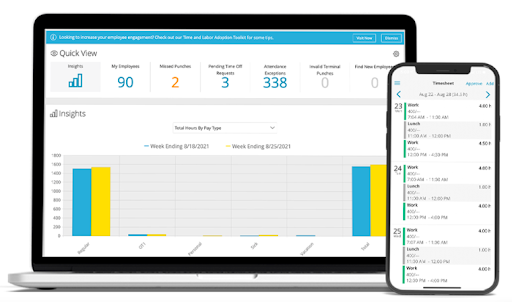
Source: https://www.paylocity.com/
Caption: Paylocity gives supervisors an overview of employee attendance week by week.
Paylocity is an HR and payroll system that helps small, mid-sized, and large businesses manage their people, payroll, and benefits. And, as part of the HR platform, Paylocity offers tools for workforce management operations like time and attendance, and scheduling.
Main features
- Communication within the platform: If employees notice a mistake or missing shift in their time cards, they can notify their manager about the errors within the system rather than having to send them a separate email.
- Supervisor dashboard: Supervisors can get an overview of pending time off requests, absences, and attendance.
- Customer service by online chat, phone, or email: Although some customers have reported that not all customer service representatives are as knowledgeable as others, they appreciate how convenient it is to access their support.
Pricing
Paylocity doesn’t list its pricing options on its website, but you can contact them for a custom price.
The Importance of Tracking Employee Attendance
Effective employee attendance tracking is a strategic approach that directly impacts a company’s bottom line and operational efficiency. High absenteeism, recorded at a staggering $225.8 billion annual cost, is a clear indicator of the financial implications of not monitoring attendance diligently. This isn’t mere conjecture; it’s backed by a 3.6% absence rate observed in 2022, underscoring a significant impact on organizational productivity and cost.
One of the most telling statistics is that nearly half of all overtime hours are attributable to employee absenteeism. This not only increases labor costs but also places additional strain on other employees, potentially affecting morale and overall performance. In contrast, organizations that have adopted attendance tracking software report a notable reduction in absence rates, nearly 20%, highlighting the efficacy of these systems.
Surprisingly, a majority of larger organizations with over 1,000 employees still depend on outdated manual tracking methods. This not only hinders accurate attendance policy enforcement but also limits the organization’s ability to make data-driven decisions. Advanced attendance tracking systems, however, offer a robust solution. They not only streamline the process of monitoring attendance but also provide valuable insights that can influence strategic decision-making.
Attendance data serves multiple purposes. It’s instrumental in managing employee performance, ensuring fair compensation, and identifying areas requiring improvement or additional training. By analyzing the time employees spend on various tasks or projects, businesses gain insights into productivity levels and can align them more closely with organizational goals.
Moreover, attendance and punctuality are key performance indicators that reflect on an employee’s engagement and motivation. These metrics are vital for businesses to understand the effectiveness of their workforce and to devise strategies that foster a more committed and punctual workforce.
Clock Out of Your Time Tracking Troubles with Homebase
Many small business owners opt for simple pen-and-paper or spreadsheet time tracking systems because they feel too intimidated by software. They worry it’ll come with too high a price tag and too much of a learning curve.
That’s why Homebase has made time tracking tools that are both free and easy to use. It only takes a few minutes to create an account and get set up. And once you’re familiar with how our app works, you can also access our free features for scheduling and team communication, which share data automatically with our time tracking software for more reliable employee management.



.png#keepProtocol)




.png#keepProtocol)
More Stories
Biggest stock movers today: Okta, Snowflake, and more (NASDAQ:OKTA)
EU leader warns of risks of wider war; NATO rules out sending troops to Ukraine
Bitcoin soars to two-year high above $56,700 as halving event looms